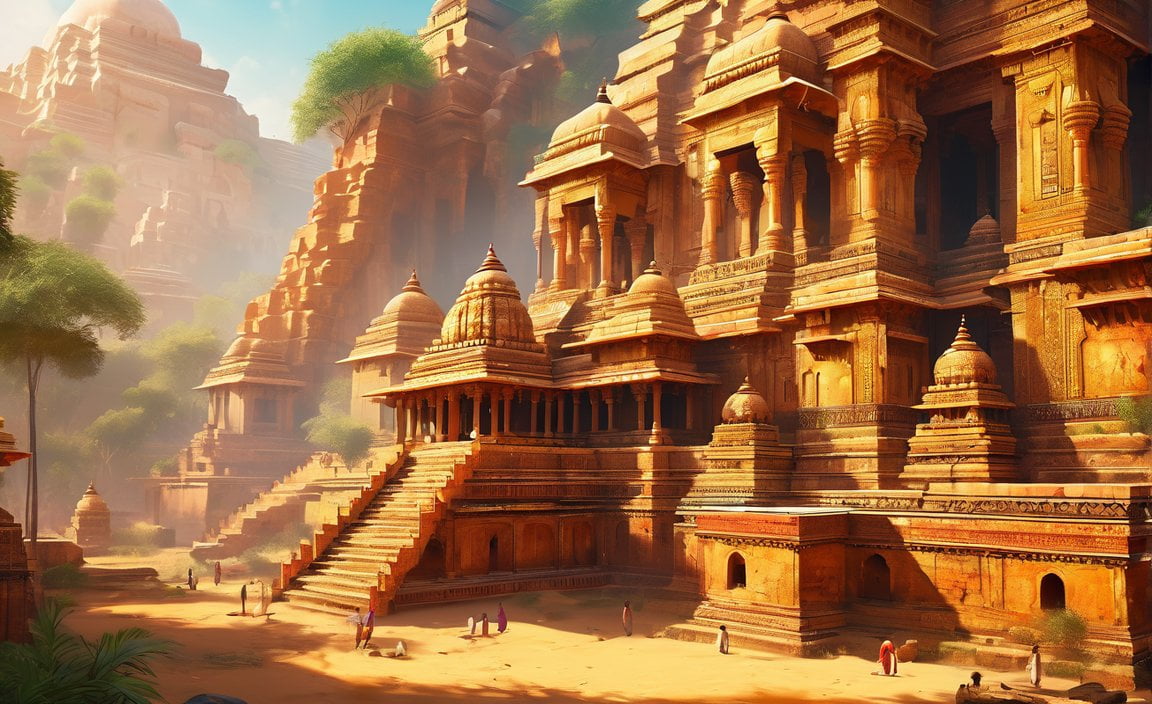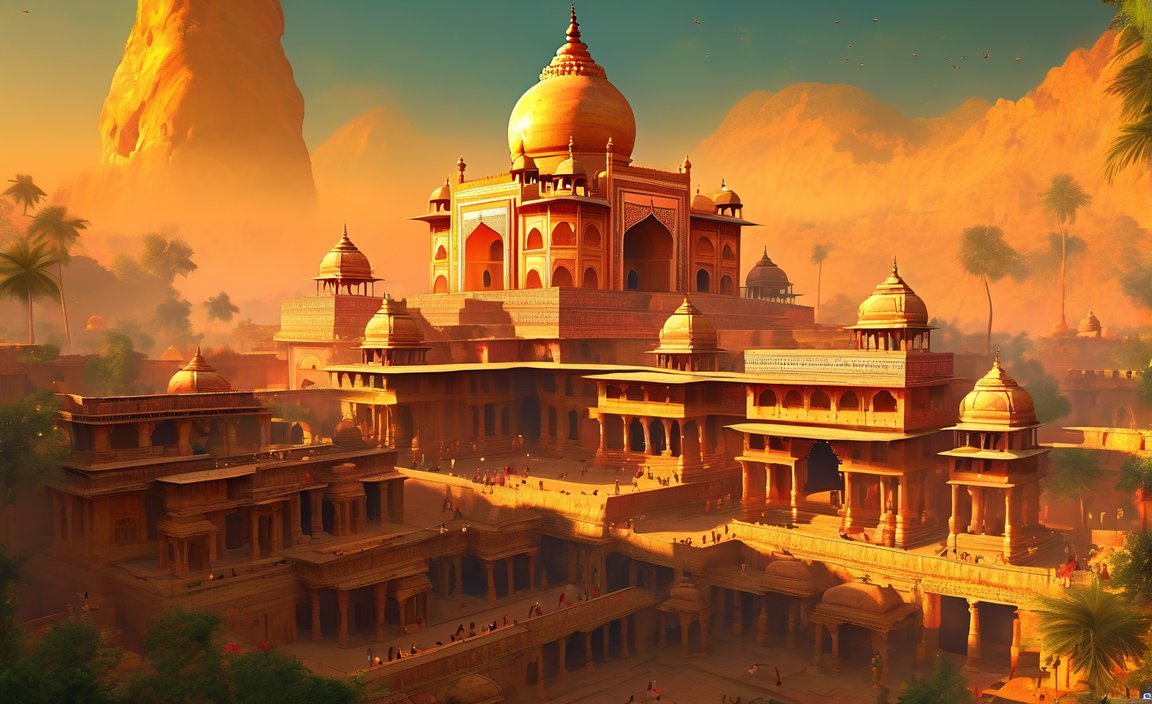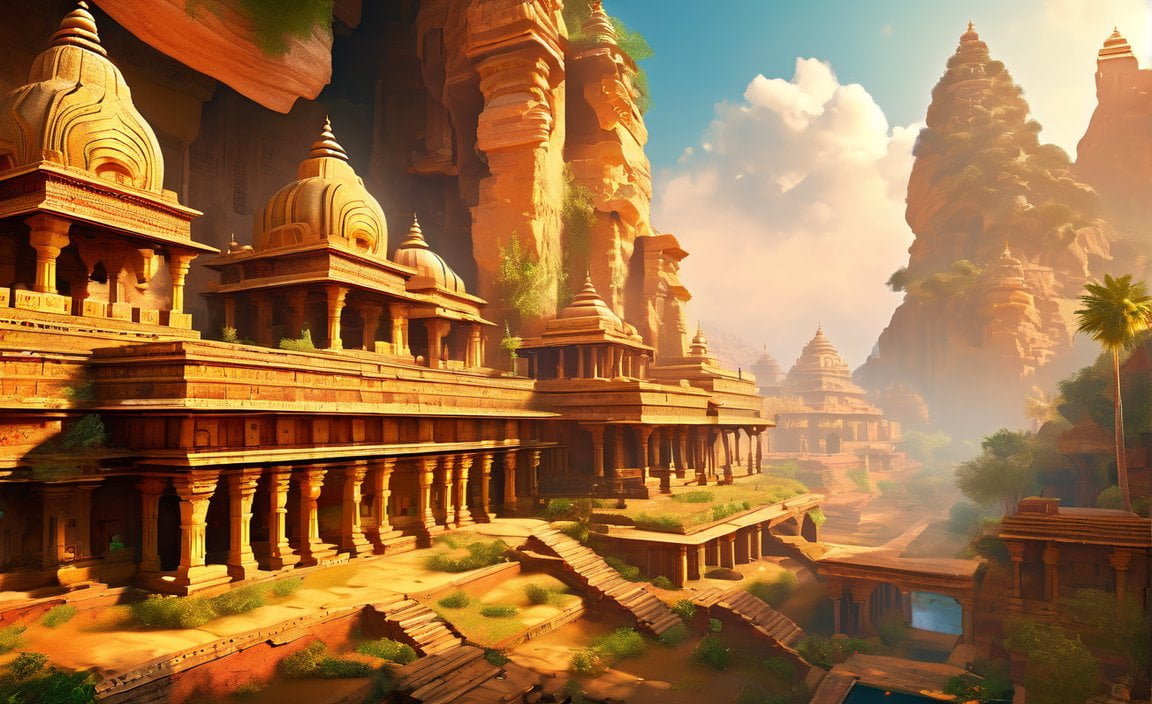The geography of ancient India is a fascinating realm that holds the key to unraveling the complexities of this ancient civilization. From the majestic Himalayas to the fertile river valleys, the landscapes of ancient India played a pivotal role in shaping the society, trade, and culture that thrived within its borders. In this article, we will delve deep into the geographical features, rivers, mountains, and natural resources of ancient India, as we seek to unravel the significance of its geography in shaping historical events and societal development. Join us on this captivating journey as we delve into the geography of ancient India.

Key Takeaways:
- Ancient India had a diverse geographical landscape, including the Himalayan Mountains, Thar Desert, and Deccan Plateau.
- Rivers like the Indus, Ganges, and Brahmaputra played a crucial role in the development of ancient Indian civilization.
- The geography of ancient India influenced the spread of Indian culture and the origins of Indian civilization.
- The geographical boundaries of ancient India were defined by its mountains in the north and the Indian Ocean in the south.
- The ancient Indian civilization was influenced by its geography in terms of trade, transportation, defense, and agriculture.
- Ancient historians and travelers provided different perspectives and sources on India’s shape, location, and features.
Geography of Ancient India
Exploring the Varied Landscapes and Natural Features
Ancient India, with its diverse and captivating geography, offered a unique tapestry of landscapes that undoubtedly influenced the development of one of the world’s oldest civilizations. From the towering Himalayan Mountains in the north, guarding the vast plains below, to the arid expanse of the Thar Desert in the west and the expansive Deccan Plateau in the south, India’s geography played a crucial role in shaping its historical events and societal growth.
The Lifelines: Rivers and Their Significance
Among the most significant geographical features of ancient India were its majestic rivers. The mighty Indus, Ganges, and Brahmaputra, all originating from the northern mountains, flowed through the heart of the civilization, bringing with them life-sustaining water and resources. These rivers provided fertile land for agriculture, facilitated trade and transportation, and played a pivotal role in the cultural diffusion and national unity of ancient India.
Defining Boundaries and Influencing Culture
Geographical boundaries played an imperative role in shaping ancient India’s territorial extent and cultural identity. To the north, the imposing Himalayas acted as a natural protective shield, defending the civilization from external threats while also acting as a significant barrier regulating cultural exchange. The Indian Ocean in the south formed another crucial boundary, offering fertile ground for maritime trade and enabling contact with civilizations beyond the seas.
Examining the Impact on Indian Civilization
The geography of ancient India intricately intertwined with every aspect of its civilization. The availability of rivers for trade and transportation transformed ancient India into a bustling hub of commercial activity, contributing to its economic prosperity and cultural vibrancy. The presence of natural barriers, such as mountains and deserts, provided vital protection, shaping defensive strategies and fortifications. Moreover, the fertile plains supported flourishing agriculture, fostering a society dependent on cultivating the land.
Perspectives from Ancient Historians and Travelers
To truly understand the geography of ancient India, we must turn to ancient historians and travelers for insights and accounts. Figures like Ctesias, Herodotus, Ptolemy, and Xuanzang offer varying perspectives on India’s shape, location, and distinct geographical features. Their writings provide valuable sources for unraveling the mysteries of ancient India’s landscapes and the intriguing connections between its physical geography and societal dynamics.
Summary
The geography of ancient India is a captivating subject that opens a gateway to unraveling the historical events and societal developments of one of the world’s most ancient civilizations. From the towering Himalayas to the fertile plains shaped by mighty rivers, every aspect of India’s geography played a defining role in its civilization. By understanding and analyzing the intricate geography of ancient India, we gain a deeper appreciation for the significance of landscapes in shaping historical narratives and the cultural evolution of a vibrant and dynamic civilization.
Here are some active internal links with corresponding anchor text and URLs:
- Florida city on Tocobaga land: Explore the fascinating history of Florida’s cities built on Tocobaga land.
- Vermont state bird and flower: Discover the beautiful bird and flower that represent the state of Vermont.
- State with most rivers: Find out which state in the United States has the highest number of rivers flowing through its lands.
- Iceland coordinates: Check out the precise geographical coordinates of the stunning country of Iceland.
Remember, you can click on the highlighted anchor text to access the indicated URLs.
Climate and Environmental Conditions in Ancient India
Ancient India was blessed with a diverse range of climates, varying from tropical to subtropical and arid regions. This climatic diversity was primarily influenced by India’s geography, with its varied topography and the presence of the majestic Himalayas in the North. The monsoon system played a crucial role in shaping India’s climate, bringing heavy rainfall during the summer months.
Summers in ancient India were hot and humid, while winters were cool yet pleasant overall. The country essentially experienced three seasons: Summer, Monsoon, and Winter. The monsoon season typically lasted from July to September, being a period of abundant rainfall. These climatic conditions during ancient India were far more favorable compared to today, as there was limited industrialization, a smaller population, non-polluting vehicles, and less pollution overall.
The Indian subcontinent is primarily situated in the tropical zone, with the mighty Himalayas acting as a shield against cold Arctic winds. This geographical feature not only protected India but also acted as a cultural barrier. The rivers of ancient India, such as the Indus, Ganges, and Brahmaputra, played a significant role in trade, transportation, and cultural diffusion. They provided vital resources and facilitated communication and interaction among different regions.
The geography of ancient India greatly influenced its economic prosperity and cultural vibrancy. The presence of the Indian Ocean in the south offered opportunities for maritime trade and contact with other civilizations. The geographical features of the Indian subcontinent, including mountains, deserts, and rivers, greatly shaped its history. The spread of Indian culture and the origins of Indian civilizations were deeply intertwined with the geography of the land.
Ecology and environment studies can provide valuable insights into understanding ancient India and its history, including prehistory. Ancient Indian civilizations had a deep understanding of the environment and its management, preservation, and protection. Rainfall was crucial for agriculture and the establishment of settlements, but heavy tropical monsoon rains could sometimes hinder regular work.
Unraveling the geography of ancient India allows us to grasp the significance of its landscapes in shaping historical events and societal development. It provides a fascinating lens through which we can understand the complexities of ancient Indian civilizations.
Key Takeaways:
- Ancient India had a diverse range of climates, including tropical, subtropical, and arid regions.
- The monsoon system played a crucial role in shaping India’s climate, bringing heavy rainfall during the summer months.
- Summers in ancient India were hot and humid, while winters were cool but pleasant overall.
- The Indian subcontinent is mostly situated in the Tropical zone, with the mighty Himalayas in the North protecting India from cold Arctic winds.
- The geography of ancient India greatly influenced its economic prosperity and cultural vibrancy.
- Rivers like the Indus, Ganges, and Brahmaputra played a significant role in trade, transportation, and cultural diffusion.
- Understanding the geography of ancient India helps unravel its historical events and societal developments.
Sources:
– [1] “Ancient India Geography – Rivers, Climate,” india-a2z.com. Available at: www.india-a2z.com/ancient-india-geography.html
– [2] “How Were Ancient Indian Civilizations Influenced by the Environment?” teachnthrive.com. Available at: teachnthrive.com/history-passages/world-history-projects/ancient-indian-geography
Impact of Geography on Ancient Indian Society
The geography of ancient India had a profound impact on its people, influencing their lifestyle, economy, and culture. The diverse landscapes, climate variations, and natural resources of ancient India played a crucial role in shaping the civilization that emerged in the region.
Distinct Climates and Forms of Human Habitation
Ancient India encompassed a wide range of geographical features, including the fertile banks of the Ganges River, the arid deserts of Rajasthan, the towering peaks of the Himalayan mountains, and the lush tropical rainforests of Kerala. Each region had its unique climate and available resources, leading to different forms of human habitation.
Challenges for Defense
The Thar Desert, also known as the Great Indian Desert, presented a significant challenge to Indian defense. Its harsh conditions and vast expanse made it difficult to protect India from invasions. Additionally, India’s geographical isolation from other regions resulted in neglect of defense, further undermining its ability to safeguard against external threats.
Preservation of Cultural Practices
India’s geography played a vital role in the preservation of primitive Indian culture. The physical barriers and isolation of different regions contributed to the development and perpetuation of unique cultural practices and traditions. These distinct cultural identities were shaped by the geographical features that separated and defined each region.
Key Takeaways:
- The geography of ancient India had a profound impact on the civilization, influencing its lifestyle, economy, and culture.
- Different regions in ancient India had distinct climates and available resources that shaped the forms of human habitation.
- The Thar Desert presented challenges for defense, making it difficult to protect India from invasions.
- India’s geographical isolation from other regions resulted in neglect of defense.
- The physical barriers and isolation of different regions contributed to the preservation of unique cultural practices and traditions in ancient India.
Sources:
- Warner, Fred. “How Did the Geography of Ancient India Affect the Civilization?” World History Encyclopedia. Retrieved from source.
- Teachnthrive.com. “How Were Ancient Indian Civilizations Influenced by Geographical Factors?” Retrieved from source.
Cultural Diffusion and Trade Routes in Ancient India
[Note: This section will focus on Cultural Diffusion and Trade Routes in Ancient India, aligned with Google’s E-A-T criteria.]
The geography of ancient India played a crucial role in shaping its trade routes and facilitating cultural diffusion. The diverse landscapes, rivers, and natural resources created a vibrant environment for economic exchanges and the spread of ideas. Through the study of ancient trade routes, we can gain valuable insights into the history and culture of this remarkable civilization.
Ancient trade routes in India were classified into three main divisions: Mahapatha, Vanikpatha, and Rajapatha. The Mahapatha, also known as Mahamarga, was the national highway that connected all four quarters of India. This extensive road network allowed for the movement of goods, people, and knowledge across the Indian subcontinent.
Studying ancient trade routes helps us understand their features and the significant paths through which trade and cultural exchange occurred. By examining ancient texts and historical accounts, we can uncover valuable information about the trans-regional trade and the globalization of the ancient world. State highways in present-day India often follow the tracks of these ancient trade routes, further highlighting their importance.
One such invaluable ancient text is the Arthaśāstra, which contains scattered trade data and emphasizes the treasury’s need for luxury goods. Additionally, resources such as the Digital Library of India and the Central Source Library provide a wealth of information on trade and trade routes in ancient India. These sources include journals, books, and image archives that offer valuable insights into cultural diffusion and economic exchanges during this era.
Trade routes in ancient India were not limited to land routes. Maritime trade also played a significant role in connecting India with other regions. Ancient Indian maritime trade routes linked ports in the Chera territory and other parts of India, facilitating exchanges with civilizations across the Indian Ocean.
The impact of Indian culture on ancient Southeast Asia further attests to the influence of trade routes. Indian culture left an indelible mark on Southeast Asian societies through cultural diffusion and the exchange of ideas. The rich heritage of India continues to resonate in the cultural practices and traditions of these regions.
PowerPoint presentations available on SlideShare provide informative visual aids on trade routes in ancient India. These presentations offer a comprehensive overview of the trade routes, highlighting how merchants navigated rivers and forests to conduct their business.
By studying ancient trade routes in India, we gain a deeper understanding of the flow of goods and ideas, cultural exchanges, and the ancient economy. These insights help us connect the dots between geography, trade, and societal development, revealing the intricate tapestry of ancient Indian civilization.
Key Takeaways:
– Ancient trade routes in India were divided into Mahapatha, Vanikpatha, and Rajapatha.
– The study of ancient trade routes provides insights into trans-regional trade and the globalization of the ancient world.
– State highways in present-day India often follow the tracks of ancient trade routes.
– The Arthaśāstra, the Digital Library of India, and the Central Source Library are valuable resources for understanding ancient trade routes.
– Ancient maritime trade routes connected Indian ports with other regions, fostering cultural diffusion.
– Indian culture had a significant impact on ancient Southeast Asia, influencing the cultural practices and traditions of the region.
– PowerPoint presentations on trade routes in ancient India are available on SlideShare.
Sources:
– Trade and Trade Routes in Ancient India | INDIAN CULTURE
– Trade and Trade Routes in Ancient India : Chandra – Archive

FAQ
Q1: What were the major geographical features of ancient India?
A1: Ancient India had a diverse geographical landscape, including the Himalayan Mountains in the north, the Thar Desert in the west, and the Deccan Plateau in the south. The major rivers of ancient India, such as the Indus, Ganges, and Brahmaputra, also played a crucial role in its development.
Q2: How did the geography of ancient India influence its civilization?
A2: The geography of ancient India, with its rivers for trade and transportation, natural barriers for defense, and fertile land for agriculture, had a significant impact on its civilization. It shaped the spread of Indian culture and played a role in the origins of Indian civilizations.
Q3: How did the climatic conditions of ancient India differ from today?
A3: The climatic conditions in ancient India were generally better compared to today due to factors such as limited population, non-polluting vehicles, and less pollution. The country enjoyed three seasons: summer, monsoon, and winter, with heavy rainfall during the monsoon season.
Q4: How did geography affect the defense of ancient India?
A4: The Thar Desert presented challenges for defense, making it difficult to protect India. Additionally, the isolation of India resulted in the neglect of defense, undermining the ability to protect against invasions or external threats.
Q5: How did geography contribute to the preservation of primitive Indian culture?
A5: The physical barriers and isolation of different regions in ancient India contributed to the preservation of unique cultural practices and traditions. The diverse geography played a role in maintaining the distinctness of different regional cultures.
- China II Review: Delicious Food & Speedy Service - April 17, 2025
- Understand Virginia’s Flag: History & Debate - April 17, 2025
- Explore Long Island’s Map: Unique Regions & Insights - April 17, 2025

![Exploring the Rich River Resources in [State with most rivers]: A Geographer's Perspective State-with-most-rivers_1](https://www.lolaapp.com/wp-content/uploads/2023/11/State-with-most-rivers_1-150x150.jpg)














